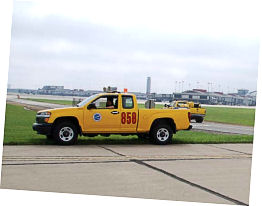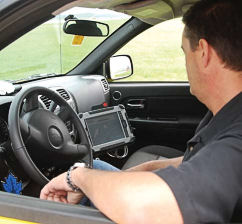Pittsburgh Int'l Tests Bio-acoustic Bird Dispersal Technology
|
Pittsburgh International |  |
|
Facts & Figures Project: Bird Dispersal Location: Pittsburgh International Airport Method: Broadcasting recorded distress calls Products: Scarecrow Premier Dispersal, UltimaTM Manufacturer: Scarecrow Bio-acoustic Systems Cost: $30,000 Trial: June - September 2009 Project Consultant: Sherwin Industries Key Benefits: Reduces risk of bird strikes; complements other wildlife control measures |
Surrounded by approximately 9,000 acres of woods, 2,000 of which are inside the fence, PIT has an abundant supply of wildlife challenges. The airport has been working with the state and the United States Department of Agriculture for the past three years to develop a multiple-tactic strategy to manage its unique challenges.
In June, the airport began testing a new method: broadcasting distress calls to disperse birds. The equipment, manufactured by Scarecrow Bio-acoustic Systems, uses birds' own languages to stimulate their natural response to flee.
"Gulls will approach the sound source and investigate the location of the 'bird in distress'," explains Tom Diamond, group commercial director with Scarecrow. "Because the predator cannot be located, the entire area becomes (considered) hostile and the birds disperse."
Other species react differently, but strategy is the same: Distress calls disperse birds rather than jolting them away with scare tactics. The vehicle-based Scarecrow Premier Dispersal system delivers the distress calls. Ultima(tm), a tablet computer-controlled addition to the system, establishes proof of dispersal in real time, logs specific species, provides time and date details and adds GPS functions. It also includes a database of bird recognition information and self-learning software.
 |  |
PIT's Process

According to Tartler, setting up the system was a simple three-day procedure. On the first day, Scarecrow fitted PIT's vehicle with the necessary hardware - mounting a processor and speakers, connecting cables and securing the Ultima tablet. At the same time, a consultant from Aerodrome Bird Management toured the airfield to survey problem areas and assess the PIT team's current level of training and approach to wildlife patrol. The second day, the consultant conducted formal training about distress calls and how to use them while technical engineers installed and customized the software to make the equipment site-specific to PIT. The final day was a "test-drive" of the system, with the PIT team sending distress calls, logging data and running reports.
 |
"We monitor and manage wildlife through many means - pyrotechnics, vehicles, horns, or if necessary, lethal action," Tartler says. "This just adds another tool to our arsenal."
The Fight for Flight

Throughout the history of aviation, sharing the sky with birds has presented a challenge. The first reported bird strike was in 1905 when Orville Wright struck and killed a goose, but landed safely.
One hundred years later, the Central Science Laboratory in the United Kingdom estimates the annual cost of bird strikes at $1.2 billion worldwide, including aircraft repair and lost revenue. The Federal Aviation Administration reports bird strikes in the United States account for more than $250 million in aircraft damage and $600 million in overall costs each year. In addition, a recent FAA report indicates that bird strikes have more than doubled at 13 major airports since 2000.
Those tracking the issue cite the simultaneous increase in air traffic and the populations of species commonly involved in strikes as a main cause. In addition, birds are adapting to urban environments, including airports, and they're less able to detect and avoid the quieter engines on modern jets. Many contend the problem is much larger than the statistics indicate, because reporting bird strikes to the FAA is purely voluntary for civil aircraft. Some say the data capture only 20% of the total strikes that occur.
No Single Solution
Bio-acoustic equipment such as Scarecrow's is one of many methods used to modify birds' behavior. Pyrotechnics, lasers, radar, dogs and firearms are other common tools. Experts also recommend changing an airport's surrounding habitat to reduce its attractiveness to birds and reorganizing aircraft flight schedules and patterns to minimize strikes.
"There isn't a magic red button in the control tower that you press and all the birds disappear," says Nigel Horton, Aerodrome Bird Management consultant on the PIT project. "There never will be, because birds are able to think. If your airport is attractive for any reason - security, food, water, etc. - they will fight to stay there. They have adapted very quickly. What they haven't evolved with is aircraft."
FREE Whitepaper
Fairbanks International Airport Baggage Transport Conveyor Enhanced With Mod Drive™ System
Airports face a host of unique industry challenges, such as meeting efficiency regulations and seeking out the best maintenance practices to reduce costs and keep operations flowing. In today’s current economic climate, any potential cost savings can go a long way.
In 2019, Alaska’s Fairbanks International Airport (FAI) sought to modernize its equipment and operations. They were dissatisfied with the performance of the gearmotors on their baggage transport conveyors and began searching for new suppliers. Regal approached FAI with a solution that could improve equipment performance and simplify maintenance, with the added benefit of energy cost savings: the Hub City® MOD Drive™ system.
This white paper discusses the hardware deployed, the test results and the annualized expectations for ROI.









